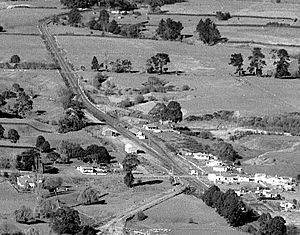Horotiu railway station facts for kids
The Horotiu railway station was a train station in Horotiu, New Zealand. It was part of the important North Island Main Trunk railway line. This line connects many towns and cities across the North Island.
| Preceding station | Following station | |||
|---|---|---|---|---|
| Ngaruawahia Line open, station closed |
North Island Main Trunk New Zealand Railways Department |
Te Rapa Line open, station closed |
||
Contents
Horotiu Station's Early Days
Horotiu was first known as a 'flag station'. This meant trains would only stop there if someone waved a flag to get on, or if a passenger on the train asked to get off.
The station was originally called Pukete. It was about 4.8 kilometers (3 miles) north of Te Rapa and 6.4 kilometers (4 miles) south of Ngāruawāhia.
Moving the Station
In 1880, the station was moved. It went a little over 1.6 kilometers (1 mile) further north. This made it 122 kilometers (76 miles) away from Auckland. No clear reason was given for this move.
On June 23, 1907, the station's name officially changed. It went from Pukete to Horotiu.
How Busy Was It?
In its early years, the station wasn't very busy. In 1901, the total money earned from tickets and goods was only £49. This shows that not many people or goods were using the station back then.
Station Upgrades and Changes
Over time, the Horotiu station received several important upgrades. These changes helped make train travel safer and more efficient.
Signalling Improvements
In 1909, Horotiu became a 'switch-out station'. This meant it could be used to control train movements on the line. In 1916, 'distant signals' were added. These signals warned train drivers about what was ahead on the track.
Around the same time, the AFFCO meat works opened nearby. Special railway tracks, called sidings, were built to connect the meat works to the station. This allowed goods to be easily loaded onto trains.
More changes to the signalling system happened in 1934. 'Automatic signalling' was extended from Mercer all the way to Frankton. This system helped trains run more smoothly and safely.
Double Tracks and New Technology
In 1930, the railway line between Frankton and Horotiu became 'double tracked'. This means there were two sets of tracks instead of one. This allowed trains to travel in both directions at the same time, or for faster trains to pass slower ones.
The automatic signalling system was also extended further to Mercer. Horotiu station was special because it had the first 'power interlocking' system in New Zealand. This was a new technology that automatically controlled the railway points (where tracks split or join). It made the old manual systems, like signals and special keys, unnecessary.
By December 5, 1937, the 5.9 kilometers (3 miles 54 chains) of track north to Ngāruawāhia also became double tracked. These upgrades helped the North Island Main Trunk line become more modern and handle more train traffic.



